
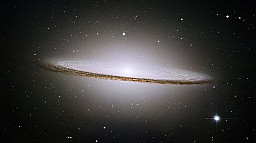 | M 104, a spiral galaxy of type Sa. | source |
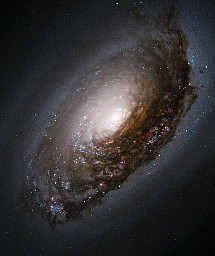 | M 64, a spiral galaxy of type Sb. | source |
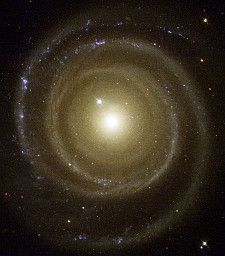 | NGC 4622, a spiral galaxy of type Sc. | source |
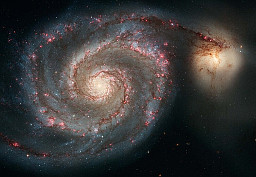 | M 51, a spiral galaxy of type Sc. | source |
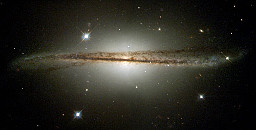 | ESO 510-G13, a twisted spiral galaxy. | source |
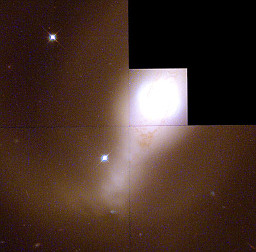 | NGC 4314, a barred spiral galaxy of type SBa. | source |
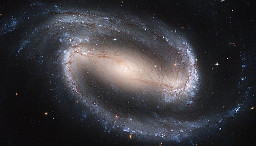 | NGC 1300, a barred spiral galaxy of type SBb. | source |
 | NGC 1097, a barred spiral galaxy of type SBbc, in optical. | source |
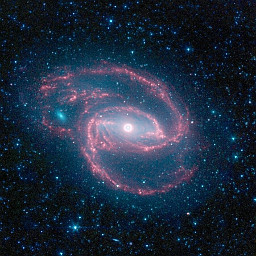 | NGC 1097 in infrared. | source |
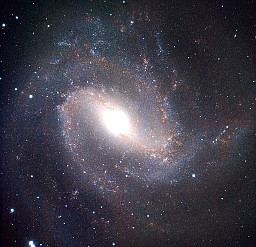 | M 83, a barred spiral galaxy of type SBc. | source |
 | M 83 in ultraviolet. | source |
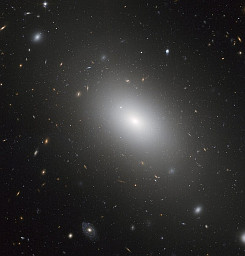 | NGC 1132, an elliptical galaxy. | source |
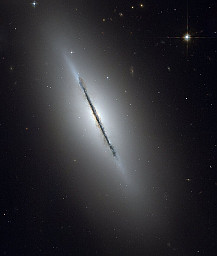 | NGC 5866, a lenticular galaxy. | source |
 | NGC 2787, a barred lenticular galaxy. | source |
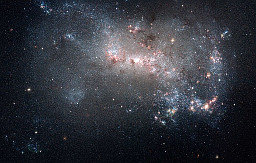 | NGC 4449, an irregular galaxy of type I. | source |
 | M 82, an irregular galaxy of type II. | source |
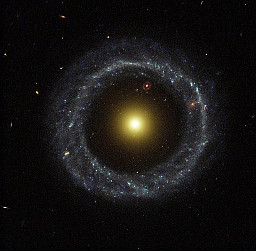 | Hoag's Object, a ring galaxy. | source |
 | NGC 4038, 4039, interacting galaxies. | source |
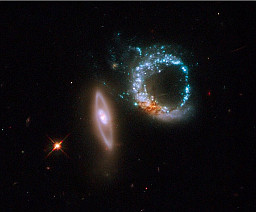 | The interacting galaxies of Arp 147. | source |
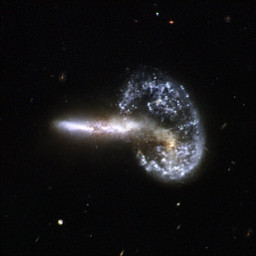 | The interacting galaxies of Arp 148. | source |
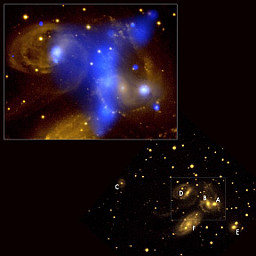 | Stephan's Quintet, x-ray gasses glowing in blue. | source |
 | Dwarf irregulars like I Zwicky 18 are thought to combine into larger galaxies over time. | source |
This simulation of galaxy interactions illustrates how unusual morphologies might form over cosmological time scales: it spans over a billion years, and produces a result comparable to NGC 7600. (source)
Note that many galaxies (for example, Centaurus A) when viewed in multiple wavelengths challenge our notions of galactic morphology gleaned from visible light observations.
The effective radius of a galaxy as measured by its interstellar gas is much larger than its visible radius; the low density in that region inhibits star formation. The 21 cm Hydrogen line is observable far beyond the stellar distribution. 21 cm discs are frequently warped.Also, see NGC 2915: a radio spiral.
(View Cosmos DVD 6, episode 10, Milky Way and galaxy interaction simulations.)Also see this site at the University of Hawaii.
Portfolio Exercise: Find an additional example of each morphological type (Sa, Sb, Sc, SBa, SBb, SBc, E, S0, SB0, I, Ring and Interacting) and verify the type using SIMBAD. Include an image and as much information as you can (including all URLs used) for each example.
The Sersic law is a useful model for the surface brightness (luminosity per unit area) of a galaxy:

I(r) = I(re) e-bm ((r / re)1/m -1),where re is the effective radius (containing half of the total luminosity), m is the Sersic index (6 for luminous ellipticals, 2 for dim ones, 1 for disc galaxies) and bm is an experimental fit, here taken to be 2m - 0.324.
Portfolio Exercise:
Using the mass-luminosity relation, plot the mass as a function of radial distance for the parameters plotted above.
Note that this will be the total mass contained within a radius r.
Central Black Holes
Since 2001 it has been known that there is a correlation between the mass of supermassive central black holes in galaxies and the mass
of the central bulge: the median black hole mass is .0013 times the bulge mass. This correlation hints that the events which lead to
the formation of supermassive central black holes are the same as the events which lead to the formation of central bulges (in spiral or
elliptical galaxies). (source)
More recently, it has been discovered that this ratio is 20 to 30 times larger for galaxies at high red shift (z > 6). (source) This seems to indicate that the black holes form before the central bulges. Interesting problem!
Note: massive black holes formed within 10 Kpc of a galactic center will spiral in to the center within the age of the universe.In a "cold" disc, conservation of angular momentum keeps a central black hole from accreting matter; with nothing to speed up the matter, its distance from the center of rotation must stay constant. During mergers, however, both the black hole and the central bulge may grow.
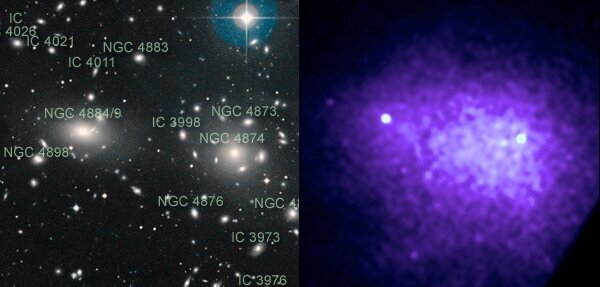
Note that much of the x-rays emanate from a region which is visually devoid of matter; although this radiation comes from hot gases which are found in most clusters, it is not dark matter.
Galaxies orbit the center of mass of their clusters. In doing so, they can interact with the intracluster medium. A particularly clear example of this is ESO 137-001, which is moving at almost seven million km/hr. In this image, the dark blue trails are x-ray data from Chandra showing the material which has been stripped from the galaxy by ram pressure:
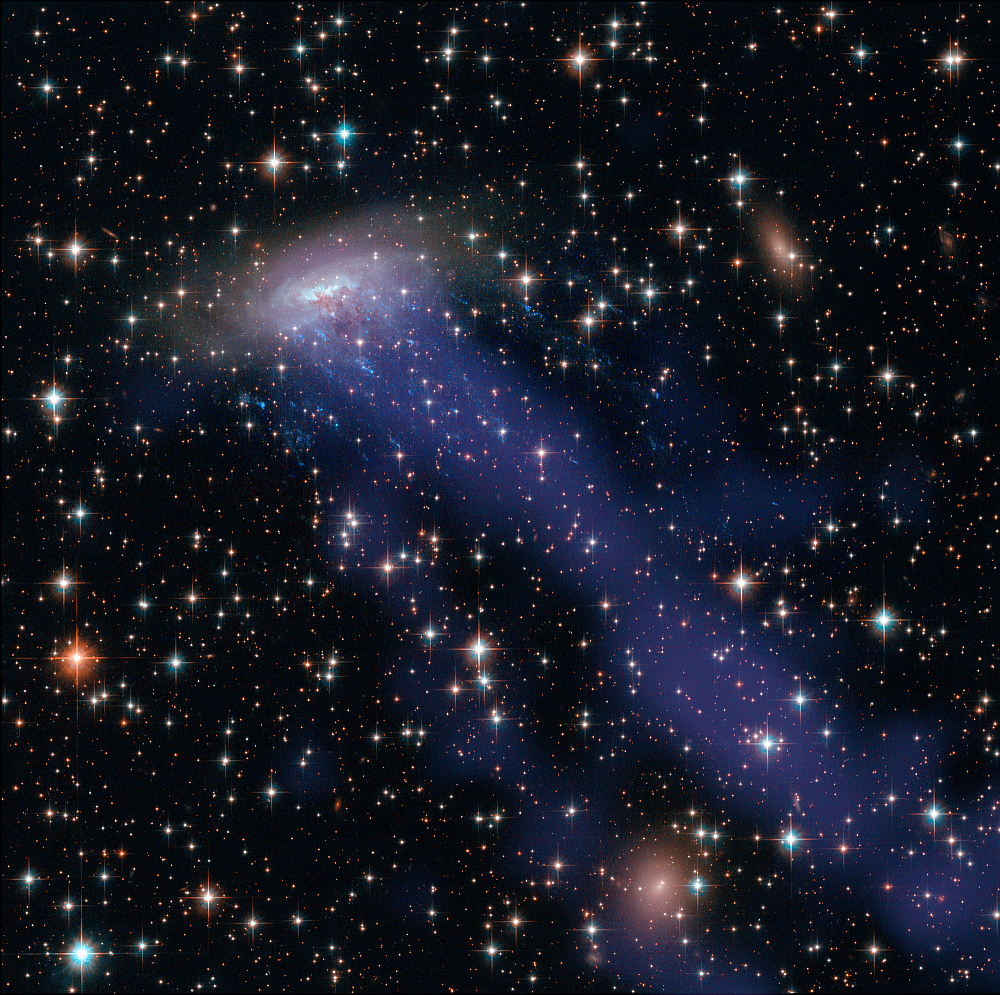
Galaxy clusters can also interact gravitationally. Here we see the results of such an interaction:

©2017, Kenneth R. Koehler. All Rights Reserved. This document may be freely reproduced provided that this copyright notice is included.
Please send comments or suggestions to the author.